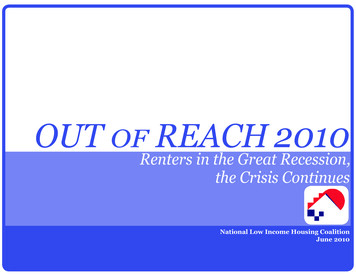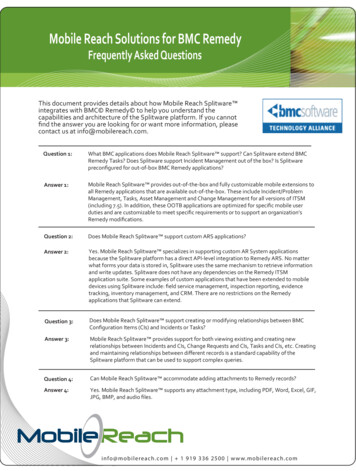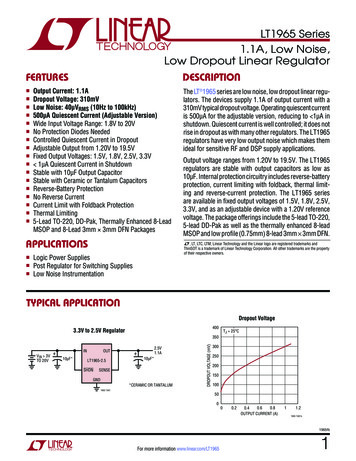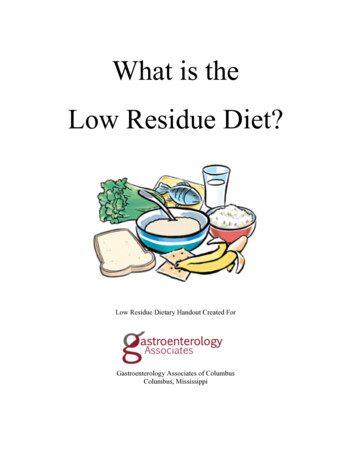
Transcription
OUT OF REACH 2010Renters in the Great Recession,the Crisis ContinuesNational Low Income Housing CoalitionJune 2010
Out of Reach2010Megan DeCrappeoResearch AnalystDanilo PelletiereResearch DirectorSheila CrowleyPresidentElisabeth TeaterResearch InternCopyright June 2010 by the National Low Income Housing Coalition
Established in 1974 by Cushing N. Dolbeare, the National LowIncome Housing Coalition is dedicated solely to achieving sociallyjust public policy that assures people with the lowest incomes in theUnited States have affordable and decent homes. NLIHC educates,organizes and advocates to ensure decent, affordable housing withinhealthy neighborhoods for everyone.The data for nonmetro areas included in Out of Reach are publishedin collaboration with the Housing Assistance Council(www.ruralhome.org).Support for this research was provided by the Housing AssistanceCouncil.NLIHC provides up-to-date information, formulates policy, andeducates the public on housing needs and the strategies for solutions.National Low Income Housing Coalition727 15th Street NW, 6th FloorWashington, DC 20005Tel: (202) 662-1530Fax: (202) 393-1973info@nlihc.orgwww.nlihc.orgAdditional copies of Out of Reach are available from NLIHC. Out ofReach and additional data are available on NLIHC’s website atwww.nlihc.org/oor2010.Permission to reprint portions of this report or the data therein isgranted, provided appropriate credit is given to the National LowIncome Housing Coalition.NLIHC Board of DirectorsMark Allison, Supportive HousingCoalition of New Mexico,Albuquerque, NMNancy Bernstine, National AIDSHousing Coalition, Washington,DCMary Brooks, Housing TrustFund Project, Center forCommunity Change, FrazierPark, CAGail Burks, Nevada Fair HousingCenter, Las Vegas, NVMaria Cabildo, East LACommunity Corporation, LosAngeles, CADelorise Calhoun, JurisdictionWide Resident Authority Board,Cincinatti Housing Authority,Cincinatti, OHDeDe Carney, Carney &Company Team, Greenville, NCDonald P. Chamberlain, SoundThinking, Seattle, WABrenda J. Clement, HousingAction Coalition-RI, Pawtucket,RIMarcie Cohen, AFL-CIO HousingInvestment Trust, Washington,DCCharles Elsesser, Jr., FloridaLegal Services, Miami, FLBill Faith, Coalition on Housingand Homelessness in Ohio,Columbus, OHMatt Gerard, MinneapolisHighrise Representative Council,Minneapolis, MNLisa Hasegawa, NationalCoalition for Asian PacificAmerican CommunityDevelopment, Washington, DCDoris Koo, Enterprise CommunityPartners, Columbia, MDLinda Leaks, Empower DC,Washington, DCMoises Loza, Housing AssistanceCouncil, Washington, DCGeorge Moses, Housing Allianceof Pennsylvania, Pittsburgh, PAReymundo Ocañas, BBVACompass, Houston, TXGreg Payne, Maine AffordableHousing Coalition, Portland, MEDiane Randall, Partnership forStrong Communities, Hartford,CTTara Rollins, Utah HousingCoalition, Salt Lake City, UTJulie Spezia, Housing California,Sacramento, CAPaul Weech, Stewards forAffordable Housing for theFuture, Washington, DCLeonard Williams, BuffaloMunicipal Housing AuthorityBoard of Commissioners,Buffalo, NY
Table of ContentsPreface: Sheila Crowley, President and CEO, National Low Income Housing Coalition .1Introduction.2Tables and MapsMost Expensive Jurisdictions .9Growth of the Two-Bedroom Housing Wage, 2000-10 .10States Ranked by Two-Bedroom Housing Wage .11Map: Two-Bedroom Housing Wage.12Map: Minimum Wage Jobs Needed Per Household.13User’s GuideWhere the Numbers Come From .14How to Use the Numbers.15State Summary Table .16State Tables.18Appendix A: Data Notes, Methodologies, and Sources.204Appendix B: Explanation of Fair Market Rent.213
PrefaceBy Sheila Crowley, President and CEO, National Low Income Housing Coalition“For more than 30 years, the National Low Income HousingCoalition has led the way in advocating for decent, affordablehousing in America. Their latest Out of Reach annual report onrental housing affordability shows a growing need to preserveand expand the current stock of affordable rental housing. Thehardships faced by many low-income renters in an economyrecovering from the recession and record foreclosures make thisneed all the more urgent. We are grateful for the NLIHC’sefforts, and we will continue our partnership to ensure that moreAmericans have better access to decent and affordable rentalhousing.” Speaker of the House Nancy Pelosi – April 2010Speaker Pelosi is one of our nation’s leaders who understandsthat good housing is fundamental to individual and family wellbeing, just as good schools, access to good health care, wellpaying jobs, and income security are. The current housing crisis,precipitated by predatory lending and the bubble in housingprices, made explicit how central stable, affordable housing is toour people, our communities, and our economy.It also has exposed the long standing structural deficit of goodhousing for the people who labor in the low wage workforce andelderly and disabled people who live on fixed incomes. This isthe story of Out of Reach. While many public officials havecited Out of Reach for years, it took the larger housing crisis thathas enveloped the nation to bring the story into full public view.The watchword in today’s housing policy debate is “balance.”We need greater balance between homeownership and renting,and equal respect paid to both. We need greater balance infederal housing subsidies, the majority of which goes to higherincome people through the tax code. We need greater balancebetween our desire for square footage and our care for our planet.We need greater balance in housing choices in every community,so that all members, no matter age, income, family status, health,or race, have equal access to safe decent and affordable homes.The purpose of Out of Reach is to make sure that every publicofficial and every housing advocate, at the local, state, andnational level, has sound and easily accessed data to argue forhousing justice and make decisions about allocating publicresources. I must first acknowledge the late Cushing Dolbeare,who founded of the National Low Income Housing Coalition andproduced Out of Reach for it first several years in the 1990s.Successive NLIHC staff have stayed true to the methodology,while enhancing Out of Reach with new data and analyses eachyear. This year Research Analyst Megan DeCrappeo, ResearchDirector Danilo Pelletiere, Communications Associate TaylorMaterio, and Research Intern Elisabeth Teater have taken Out ofReach to a new level of excellence.National Low Income Housing Coalition Out of Reach 2010 - June Update1
IntroductionHousing issues have been at the forefront of Americans’ mindsPersistent Problems and Troubling Trendsfor over 3 years now and while there have been a number ofattempts at all levels of government to improve the health of theThe numbers in Out of Reach 2010 do not appear in isolation.housing market, low income people andThey are a part of the broader economic andrenters in particular continue to struggle tosocial forces affecting the opportunities andBox 1: Statistics for extremely lowremain in their current homes or find anhousing choices Americans face in theirincome renter households as of 2008:adequate and affordable place to live. The 71% spent more than half of theircommunities.majority of the initiatives aimed atincome on rent. There was a shortage of 3.1 millionstabilizing the housing market over theAffordable Housing Shortage: Since longaffordable units.past few years have focused almostbefore the current foreclosure and economic Only 37 units were affordable andexclusively on the needs of homeownerscrises, low income renters have faced a largeavailable for every 100 households.and on encouraging people to buy homes,array of housing challenges. Extremely Lowrather than on providing incentives forIncome (ELI) renter households (those earningpeople to rent or on making rental units more affordable.30% or less of their area’s median family income) continue to bethe only income group facing an absolute shortage of affordableAs the housing crisis evolves into one of the worst economichousing units, with only 6.1 million units affordable to 9.2recessions in recent history, economic hardship is being felt by amillion ELI renters. 1wide swath of the population. With so much of the nation’sattention still focused on the housing market and on alleviatingHowever, if only apartments that are both affordable andthese hardships, it is critical that advocates of affordable housingavailable are counted, this number shrinks to a mere 3.4 millioncontinue to inform the public about the persistent affordableunits for all ELI renter households. Further illustrating thehousing crisis facing low income renters, a crisis that has onlyproblem is the fact that from 2000 to 2008 the number of unitsworsened in the current recession. The argument in favor of areceiving project based assistance from HUD decreased by overmore balanced housing policy, one that seeks to provide housingto those in the greatest need and stabilize the lives of Americanfamilies whether they rent or own, has never been stronger.1Pelletiere, D. (2009, November). Preliminary assessment of AmericanCommunity Survey data shows housing affordability gap worsened for lowestincome households from 2007 to 2008. Washington, DC: National LowIncome Housing Coalition.2National Low Income Housing Coalition Out of Reach 2010 - June Update
210,000. 2 This mismatch in the supply and demand of affordablehousing leads to an astonishingly high number of ELI renterswho pay more than half of their income on housing costs (SeeBox 1). 3More People are Doubling Up: Those households that can’t orare unwilling to devote such a large percentage of their incometowards housing costs may decide to move in with familymembers or friends, or live in substandard housing that lacksnecessary amenities such as working plumbing or electricity.Recent HUD data shows a 25% increase from 2005 to 2009 inthe percentage of movers who joined an existing household, or“doubled up. 4”Additionally, a recent study by the Pew Research Center 5showed that the number of “multi-generational” familyhouseholds, or households containing at least two adultgenerations, increased by 33% between 1980 and 2008. Whilesome of this increase may be attributed to demographic andcultural shifts, such as a larger immigrant population or the risingmedian age of marriage, a large increase of 2.6 millionAmericans living in multi-generational households between 20072NLIHC tabulations of HUD’s “A Picture of Subsidized Households” from2000 and 2008.3Statistics in Box 1 are from NLIHC tabulations of the 2008 AmericanCommunity Survey PUMS housing file.4Collinson, R. & Winter, B. (2010, January). U.S. rental housingcharacteristics: supply, vacancy, and affordability. HUD PD&R WorkingPaper 10-01. Washington, DC: U.S. Department of Housing and UrbanDevelopment.5Taylor, P. et al. (2010, March). The Return of the Multi-Generational FamilyHousehold. A Social & Demographic Trends Report. Washington, DC: PewResearch Center.and 2008 points to high unemployment and rising foreclosures aspart of the reason for this trend.Rise in Homelessness: For the lowest income families that cannot find affordable housing, homelessness threatens. There wereover 650,000 homeless people in the U.S. in 2008. Homelessnessin individuals remained largely unchanged from 2007 to 2008,but homelessness in families increased by 9%, and increases inboth populations were more substantial in rural and suburbanareas than in principal cities. The increase in familyhomelessness seems to be a direct result of the recession, sincefamilies have historically been more immediately impacted bychanging economic conditions than individuals. 6 The Center onBudget and Policy Priorities estimated that the number of peoplein “deep poverty,” or with incomes below half of the poverty lineand therefore at risk of housing instability and homelessness,would increase by somewhere between 4.5 or 6.3 million if theunemployment rate reached 9%. 7 In December 2009 theunemployment rate reached 10%. 8Unemployment Remains High: According to data from theBureau of Labor Statistics (BLS) the number of unemployedpersons at the beginning of the recession (December 2007) was7.7 million and the unemployment rate was 5%. By December6Office of Community Planning and Development. (2009, July). The 2008annual homeless assessment report to Congress. Washington, DC: HUD.7Sard, B. (2010, January). Number of homeless families climbing due torecession: recovery package should include new housing vouchers and othermeasures to prevent homelessness. Washington, DC: The Center on Budgetand Priority Policies.8Bureau of Labor Statistics. (2010, January). The employment situation:December 2009. Washington, DC: U.S. Department of Labor.National Low Income Housing Coalition Out of Reach 2010 - June Update3
2009, both the number of unemployed and the unemploymentconditions. 12 In hard financial times, people often try to workrate had doubled to 15.3 million and 10% respectively. 9 Amultiple jobs in order to make ends meet, but in a recession suchdiscouraging upward trend comes in the increasing number ofas this, it becomes difficult to find one job, much less two orlong-term unemployed persons. Fromthree. This is reflected in the decreasingDecember 2008 to December 2009, thenumber of people holding multiple jobs, whichBox 2: Measures of the currentnumber of people unemployed for 27 weekswent from 7.7 million in February 2009 to 7.2crises:or longer more than doubled, increasingmillion in February 2010. 12 The unemployment rate has10from 2.6 million to 6.1 million.increased from 8.2% to 9.7% in thelast 12 months.Foreclosure and the Rental Market: The ThepercentageofpeoplewhohaveUnfortunately, unemployment rates areforeclosure crisis has had a dramatic effect onbeen unemployed for 27 weeks orhighest among minorities (15.8% forthe housing market. Rental demand continueslongerincreasedfrom22%to40%African Americans and 12.4% forto surge as more and more people are eitherin the last 12 months.Hispanics), people with disabilitiesforced out of ownership due to foreclosure or An estimated 40% of foreclosures(13.8%), and those without a high schoolchoose to rent rather than own in light of thedisplace renter households.diploma (15.6%), 11 groups which also tendtightening credit market and now obvious risks The number of renter householdsto have historically high proportions of lowinvolved with homeownership. Rentergrew by 1.1 million between 2007income households. Contributing to highhouseholds currently make up 33% of the totaland 2008, while the number ofoccupied housing units, up from only 31% atunemployment rates among theseowners contracted.populations is the loss of jobs in industriesthe height of the housing boom in 2004. 13 There has been a 25% increase inrenters who move to join anotherthat are traditionally available to thosefamily (or “double up”) since 2005.Even with this increased demand for rentalwithout higher education, such asmanufacturing and construction.housing, for-rent vacancy rates are at historichighs. The for-rent vacancy rate in the fourth quarter of 2009 was10.7%, up from 10.1% in the fourth quarter of 2008. 14Among those who are unemployed but want a job, the number ofHomeowners and investors who are overleveraged and face thediscouraged workers (or those who think that there are no jobsthreat of delinquency or foreclosure are increasingly looking foravailable to them) has increased by 500,000 over the past year,indicating a growing frustration with current economic12Ibid.Ibid.13U.S. Census Bureau. Housing vacancies and homeownership (CPS/HVS)fourth quarter 2009, historic tables, table 7. Washington, DC: Author.14U.S. Census Bureau. Housing vacancies and homeownership (CPS/HVS)fourth quarter 2009, historic tables, table 1. Washington, DC: Author.129Ibid.Ibid.11Bureau of Labor Statistics. (2010, March). The employmentsituation:February 2010. Washington, DC: U.S. Department of Labor.104National Low Income Housing Coalition Out of Reach 2010 - June Update
renters or roommates to help them with their high debt paymentspushing up the number of units for rent. There is some evidencethat rents in large, professionally managed apartment buildingsdeclined in all four quarters of 2009. 15However, it is important to keep in mind that from 2001 to 2007the high-rent rental housing stock increased by 94.3% as theaffordable rental housing stock decreased by 6.3% and it is thesehigh-rent developments, along with units now for-rent that werepreviously for-sale that are contributing to these higher vacancyrates and declining rents. 16 These units remain unaffordable forthe growing number of low income households looking for lowcost housing. The CPI rent index, which covers all rentalhousing, shows rents continuing to rise despite the economicslowdown. 17While the nation has focused almost exclusively on the troublesin the single-family homeownership market, a second crisislooms in the commercial real estate market. The multifamilymortgage default rate increased in recent quarters and was at3.58% in the third quarter of 2009, up from 3.14% in the secondquarter. 18 Apartment owners face a tightening credit market,decreasing property values and many are highly overleveraged.These characteristics will make it difficult for them to refinancetheir mortgages and they may resort to tactics such as foregoingnecessary property improvements or passing along theirincreased debt payments in the form of higher rents or fees totenants.An estimated 40% of the households displaced by foreclosure arerenters, 19 a number which may rise significantly if conditions inthe multifamily market continue to deteriorate. Renters tend tohave lower incomes than owners and end up paying a largerproportion of their income on housing costs, making them morevulnerable to a weak job market than traditional homeowners.Two Fundamental QuestionsAs a result of the swelling ranks of unemployed and householdswho have been foreclosed upon or evicted from their homes,there will be a large number of households searching for anaffordable place to live in 2010. Unfortunately, low incomehouseholds will continue to compete with higher incomehouseholds for a pool of low-cost units that was insufficient tomeet demand in the first place.For the family who has to relocate to a new community to findwork – or for the family who has been displaced by foreclosureand wants to remain in the same town – Out of Reach answerstwo fundamental questions:1. How much will I have to earn to be reasonably assured offinding an affordable rental unit?15National Multi Housing Council. (2010, March). Market Trends.Washington DC: Author.16Collinson & Winter. (2010, January).17National Multi Housing Council. (2010, March).18Congressional Oversight Panel. (2010, February). Commercial real estatelosses and the risk to financial stability. Washington DC: Author.19Pelletiere, D. (2009, January). Renters in foreclosure: Defining the problem,identifying solutions. Washington, DC: National Low Income HousingCoalition.National Low Income Housing Coalition Out of Reach 2010 - June Update5
2. At prevailing wage levels, will a full-time job allow me tofind a decent home I can afford?The Housing Wage answers the first question. It represents thefull-time 20 hourly wage one would need to earn in order to paywhat HUD estimates to be the Fair Market Rent (FMR) for anapartment, spending no more than 30% of income on housingcosts.To answer the second question, Out of Reach compares theHousing Wage to local wage and income levels for every county,metropolitan area, state, and nonmetropolitan portion of everystate in the country.By answering these two questions in this way, the numbers inOut of Reach allow readers to gain a clear understanding of thedifficulty that low income households face in finding a homethey can actually afford in their community with the wages theyearn. Advocates can use the following findings to make the casethat there is still a pressing need to create more affordable rentalhousing in this country in an effort to narrow the gap between theHousing Wage and what Americans actually earn.20Full-time work is defined as 2,080 hours per year (40 hours each week for52 weeks). For households that cannot work 40 hours per week, this is aconservative estimate because the required income must be earned in fewerhours. For households working more than 40 hours per week, the HousingWage is actually lower than is stated here. The average employee worksroughly 34 hours per week (Bureau of Labor Statistics. (2010, March). Theemployment situation: February 2010. Washington, DC: U.S. Department ofLabor).6FindingsAssuming full-time, year-round employment, the 2010 nationalHousing Wage for a two-bedroom rental unit at the nationalaverage FMR of 959 is 18.44. This means that a householdmust earn the equivalent of 38,360 in annual income to afford amodest rental home. 21 There are two states in which the HousingWage actually decreased from 2009 to 2010: Michigan andOklahoma. This was due to economic weakness and declines ofthe FMRs in large metropolitan areas of these states such as AnnArbor, Detroit and Oklahoma City.Minimum Wage: In all but 15 states, the minimum wage in effectin the first part of 2010 is greater than at the same time last year,in many cases because the federal minimum increased to 7.25 inthe summer of 2009. As a result, the distance between theminimum wage and many state Housing Wages narrowed andthe number of jobs per household at the prevailing minimumwage needed to afford the two-bedroom FMR decreased in 27states.Despite this progress, the number of full-time jobs that ahousehold must work at the prevailing state minimum wage toafford the average two-bedroom FMR ranges from 1.1 jobs(Puerto Rico) to 4.3 jobs (Hawaii). In other words, in no state canan individual working full-time at the minimum wage afford atwo-bedroom apartment for his or her family. In fact, with theexception of 32 Municipios in Puerto Rico, there is no county in21The data contained in this printed version are supplemented by additionaldata online, such as the Housing Wages for an array of apartment sizes (0-4bedrooms).National Low Income Housing Coalition Out of Reach 2010 - June Update
the U.S. where even a one-bedroom unit at the FMR is affordableto someone working full-time at the minimum wage. Also, thereare no further projected increases to the minimum wage, so it islikely that the gap between the housing wage and the minimumwage will begin to widen again next year.Renter Wage: At the estimated averagerenter wage of 14.44, a household mustwork 51 hours per week to afford thenational average two-bedroom FMR. Thisaverage renter wage decreased from 14.69 in 2009, as the recession took itstoll on wage earners. Ninety-six hours, orroughly 2.4 full-time jobs, are required atHawaii’s renter wage to afford the state’stwo-bedroom FMR, while only 39 hoursare required in Texas.Supplemental Security Income: Roughly 7.7 million individualsreceive Supplemental Security Income (SSI) because they areelderly, blind, or disabled and have few economic resources. 23With the maximum federal monthly payment of 674 in 2010, anSSI recipient could afford rent of only 202. 24Box 3: State-Level FindingsSSI is the only source of income for 56% of all In 28 states (including DC), morerecipients. 25 than two full-time minimum wagejobs are required to afford the twobedroom FMR.In 20 states, a household must workat least 50 hours at the averagerenter wage to afford the twobedroom FMR.In 29 states, an ELI householdcannot afford to spend more than 500 per month on rent and utilities.In 16 states, the FMR for a studioapartment exceeds the entiremonthly SSI payment.In 13 states, a household must workat least two full-time jobs at theminimum wage to afford the twobedroom FMR in the state’scombined nonmetropolitan areas.ELI Households: HUD defines an ELI household as one that earns 30% or less ofthe Area Median Income (AMI). Thirtypercent of the national average AMI is 19,740 22 which, assuming a householdspends no more than 30% of its income onhousing, implies that an ELI householdcould afford no more than 494 in monthly rent. Comparing theamount an ELI household can reasonably afford to the nationaltwo-bedroom FMR of 959 illustrates the true disparity betweenprevailing and affordable rents for ELI households.22This number differs from the estimated national average AMI that wasincluded in the original release of Out of Reach 2010. This release includesHUD’s official FY10 AMIs, which were released in May, 2010.Nonmetropolitan Areas: For each state, Out ofReach combines the data for counties that arenot included in a metropolitan area andcalculates the Housing Wage and relatedstatistics for this combined area. Althoughhousing is often less expensive in rural areasthan in big cities, these areas also generallyhave lower wages than are found inmetropolitan areas. To illustrate, the averagenonmetropolitan FMR of 699 is roughly threefourths of the national FMR ( 959), but thesame relationship applies to the renter wagessince the average renter wage innonmetropolitan areas is only 10.37. Thus, aswith the national statistic, the average nationalnonmetropolitan FMR is affordable only by23Social Security Administration. (2010, March). SSI monthly statistics,January 2010. Washington, DC: Author. Retrieved March 29, 2010 comps/ssi monthly/24Because SSI payments are reduced for beneficiaries who report othersources of income, the average federal payment in January 2010 was 476.However, 46 states supplement the federal payment for all or a subset ofrecipients, depending on the state. See Appendix A.25Social Security Administration. (2009, September). SSI annual statisticalreport, 2008. Washington, DC: Author.National Low Income Housing Coalition Out of Reach 2010 - June Update7
working 52 hours at the average renter wage in these areas.The Numbers in this ReportConclusionsYear after year, the statistics found in Out of Reach show theeffects of the severe shortage of housing that is both decent andaffordable to low income renters. Out of Reach 2010 shows thateven with the recent increases to the federal minimum wage anda weak housing market, households still need to work over 40hours a week or hold down multiple jobs to be assured of beingable to afford a modest rental home; a task made harder in therecession.While some may point to recent spikes in rental vacancies orreports of declining rents as an indicator that there is no longer aneed to create more affordable housing, housing advocates canuse Out of Reach 2010 statistics to show that the need remains.Wages are decreasing, unemployment remains at an historic highand the rents low income people pay continue to go up, all whilemore and more households are entering the rental market. It isharder than ever for households to find decent, stable housing atthe wages they earn.As in past years, Out of Reach 2010 relies on data from HUD,the U.S. Census Bureau, the Bureau of Labor Statistics, theDepartment of Labor, and the Social Security Administration tomake its case. See Appendix A for a detailed explanation of datasources and methodologies.The FMR on which the Housing Wage is based is HUD’s bestestimate of what a household seeking a modest rental unit in ashort amount of time can expect to pay for rent and utilities inthe current market. Thus, the FMR is an estimate of what afamily moving today can expect to pay for a modest rental home,not what current renters are paying on average. See Appendix Bfor information on how HUD calculates the FMR.Readers are cautioned against comparing statistics in one editionof Out of Reach with those in another. In recent years, HUD haschanged its methodology for calculating FMRs and incomes. Thenew methodology is thought to be an improvement on pastpractices, but it can introduce more year-to-year variability intothe data. For this reason and others (e.g., changes to themetropolitan area definitions), readers should not compare thisyear’s data to previous editions of Out of Reach andautomatically assume that differences reflect actual marketdynamics. Please consult the appendices and NLIHC researchstaff for assistance interpreting the data.The data in this report and the additional materials and datacan be found online at www.nlihc.org/oor2010/.8National Low Income Housing Coalition Out of Reach 2010 - June Upda
necessary amenities such as working plumbing or electricity. Recent HUD data shows a 25% increase from 2005 to 2009 in the percentage of movers who joined an existing household, or "doubled up.4 " Additionally, a recent study by the Pew Research Center. 5. 2. NLIHC tabulations of HUD's "A Picture of Subsidized Households" from 2000 .











